Initiatives in 2015
for business entities and workplaces
In response to requests from those in charge of health and safety at business entities, Otsuka Pharmaceutical has helped with and sent instructors to heat disorders prevention seminars conducted in the workplace, and given talks at sites where employees work in hot environments. The company has also helped compile heat disorders prevention guidebooks for the Japan Industrial Safety & Health Association and Japan Construction Occupational Safety and Health Association. Otsuka is also working to publicize and promote an understanding of directives* regarding the prevention of heat disorders issued by the Ministry of Health, Labour, and Welfare and the Ministry of the Environment.
- *Drinking water with a salt concentration of 0.1-0.2% is recommended to prevent heat disorders. This is the equivalent of 40-80 mg of sodium in 100 ml.
Sources: "On Preventing Heat Disorders in the Workplace," Ministry of Health, Labour, and Welfare (June 2009); and "Manual for Staying Healthy in Heat Disorders Environments," Ministry of the Environment (May 2011 revised edition).
Bridgestone Corporation
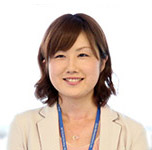
"We tried to make the seminars accessible and fun for employees of Bridgestone Corporation."
Sales Promotion Manager, Tachikawa Office, Tokyo Branch,
Nutraceuticals Business Division,
Otsuka Pharmaceutical Co., Ltd.
Mayumi Iwata
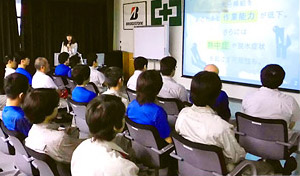
I served as instructor for 19 heat disorders prevention seminars that were conducted at the Tokyo Plant and Technical Center of Bridgestone Corporation.
We first met with Bridgestone staff to receive their input on the seminar content. The seminars themselves included information on the symptoms of heat disorders, and also focused on concrete action to be taken such as reporting initial heat disorders symptoms to supervisors and responding to heat disorders. The other area of focus was on routine habits that help prevent heat disorders, such as getting enough sleep, eating breakfast, and limiting alcohol intake. We made the seminars longer and added more content, while changing the tone of the presentation to make it more accessible and fun for participants.
Having conducted several seminars at Bridgestone, it is encouraging to hear from the employees who have attended the seminars.
I look forward to having more opportunities to observe and experience the production floor at Bridgestone and listen directly to employees, so that we can make the seminars even better.
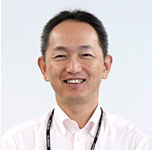
General Manager,
Kodaira General Affairs
Department,
Bridgestone Corporation.
Satoshi Ishida
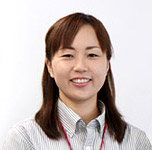
Facilities Safety Section,
Tokyo Plant,
Bridgestone Corporation.
Yuko Tagami
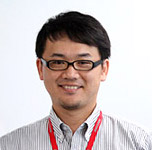
General Affairs and
Environmental Section,
Tokyo Plant,
Bridgestone Corporation.
Kan Otsuka
The Bridgestone Tokyo Plant is strengthening both its tangible and non-tangible measures for heat disorders prevention. This year, we had our measures in place before the temperature rose, receiving shipments of POCARI SWEAT and OS-1 oral hydration solution on May 31, and pickled plums (to be eaten when dehydrated) on June 3. Last year, we conducted six seminars on heat disorders prevention, but some employees were not able to attend for work reasons. This year we conducted 12 seminars to ensure that everyone could attend.
The seminars help employees to understand the causes of heat disorders, and the content has been further refined to facilitate preventive action. For example, we learned that we need to hydrate before our throats feel dry, and that someone who weighs 60 kilograms has already lost 1.2 liters of water by the time they experience a dry throat. This information reinforced the importance of rehydrating and replenishing sodium at the right time. The seminar also included guidance on everyday food intake and healthy habits, supplying a broad range of information together with concrete and effective strategies for the prevention of heat disorders.
This year, we expanded the scope of the seminars to include the participation of subcontracted employees responsible for the maintenance of our facilities, in addition to our own employees, to improve heat disorders awareness for everyone working at the Tokyo Plant. This is helping us to maintain our record of no heat disorders cases at the plant.
The heat disorders prevention seminars are part of a larger project this year that is being conducted in partnership with Otsuka Pharmaceutical, in an effort to make our workplaces better for employees through heat disorders prevention and three other areas of focus.
We will continue working with Otsuka Pharmaceutical to conduct these seminars, and strive to make the content even more accessible by incorporating feedback from the production floor.
- *Weighing an average of 60kg
Hino Motors

Bringing the message of heat disorders prevention to the production floor
Sales Promotion Manager, Tachikawa Office,
Tokyo Branch,
Nutraceuticals Business Division,
Otsuka Pharmaceutical.
Akinori Abe
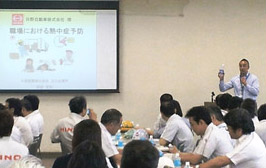
This is our third year of conducting heat disorders prevention seminars in partnership with Hino Motors. Until last year, the seminars were only held for managers who voluntarily signed up. This year, we expanded the seminars to include the participation of department leaders from production floors where the temperatures can be high.
Many people on the production floor still believe that it is sufficient to drink water or tea to avoid heat disorders; the seminars teach employees about the role of sodium and sugar for hydration.
The seminars now encourage leaders on the production floor to check the faces of their staff for signs of dehydration, so that they can warn staff if needed. In addition to providing basic information about heat disorders, we tailored the seminar content to the needs of the production floor, by providing data about departments that experienced heat disorders cases prior to last year and other data such as the ages and years of experience of employees who experienced heat disorders.
We will keep working to raise awareness of the dangers of heat disorders and convey preventative strategies, in an effort to eliminate heat disorders altogether. We will work hard to ensure that the customer is happy to have partnered with Otsuka Pharmaceutical.
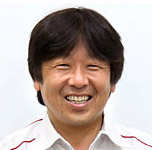
Manager, Safety Management Group,
Plant Management Division,
Hino Motors, Ltd.
Noriichi Takagi
In 2011, Hino Motors launched a major internal campaign to address heat disorders, focusing on raising employee awareness. As part of this effort, the Hino Plant launched seminars to provide employees with essential information about heat disorders, starting in July 2011. These seminars were aimed at the 410 managers who worked at the plant, out of a total workforce of some 2,300 persons. In 2013, we expanded the seminars to include the 600 department leaders who work at the plant, and started conducting the heat disorders prevention seminars as early as May before temperatures started to climb.
These seminars provide basic information, including details of the mechanism and symptoms of heat disorders and the appropriate response. This year, the seminars incorporated information about which persons are most at risk and when heat disorders are likely to occur, based on data of the age group, years of experience, and departments experiencing heat disorders cases at our plant. The content was also updated with information to help department leaders prevent and respond to heat disorders.
On the production floors at our plant, we keep refrigerators stocked with POCARI SWEAT and pickled plums (to be eaten when dehydrated). Department leaders urge their staff to regularly rehydrate and take in sodium, and we try to make it easier for employees to buy rehydration drinks by stocking vending machines and concession stands with POCARI SWEAT and POCARI SWEAT ION WATER.
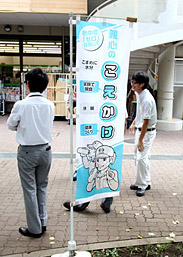
Department leaders receive a heat disorders email alert when the WBGT*1 is projected to rise, and if temperatures rise to cautionary levels, we issue a warning over the plant PA system. We have installed approximately 65 banners around the plant that urge employees to take proper precautions (frequently rehydrate, eat breakfast, get enough sleep, and adopt healthy habits) to eliminate heat disorders.
From the start of our campaign, Otsuka Pharmaceutical has cooperated by providing tools and sending instructors to conduct the seminars. This year, Otsuka Pharmaceutical also handed out liter-size squeeze bottles so that personnel can conveniently rehydrate and ingest sodium. We look forward to Otsuka Pharmaceutical's continued support, including receiving their advice and providing us with statistical data on actual heat disorders cases that we can apply to our efforts here at Hino Motors.
- *1WBGT (wet-bulb globe temperature): An index that accounts for humidity, radiant heat, and temperature, which significantly affect the heat balance in the human body. WBGT is calculated using values for dry-bulb temperature, wet- bulb temperature, and globe thermometer temperature.
Toyota Motor Corporation
Report on Three-Year Project to Eliminate Heat Disorders
Nutraceuticals Division, Nagoya Branch Office
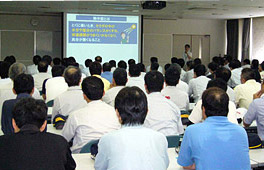
In 2010, the Nagoya Branch Office, through a partnership between Toyota Motor, Toyota Co-Op, Otsuka Foods (vending machine support), and Otsuka Pharmaceutical launched a three-year project to eliminate heat disorders at Toyota Motor Corporation.
The initiative centers on the three cornerstones of knowledge and education (Otsuka Pharmaceutical), awareness raising (Toyota Motor), and good access (Toyota Co-Op and Otsuka Foods). Each of the four companies took on a separate area of responsibility and participated in regular meetings to check the progress of the measures and identify issues, working together to eliminate heat disorders cases.
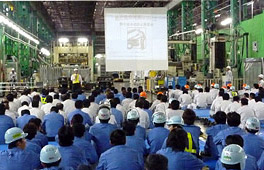
Every year, the project staff prepared measures based on outcomes and issues identified in the previous fiscal year, emphasizing continuous activities, improvements, and new initiatives. These three areas were also incorporated into the knowledge and education aspect, centering on the seminars on heat disorders prevention. In three years, we conducted seminars at 201 workplaces, attended by 12,108 employees.
Although the project ended in 2013, we will continue to provide education for Toyota Motor employees that comprehensively supports their health. Starting in fiscal 2013, we began actively conducting mini-seminars on health and heat disorders prevention, emphasizing the importance of healthy habits. This emphasis reflects the fact that many people suffer heat disorders because of a lack of sleep, not eating breakfast or lifestyle illnesses, rather than from a lack of hydration or sodium intake. Furthermore, many employees complain of poor health during the summer, without it actually developing into heat disorders.
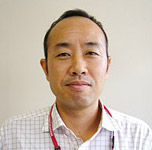
Healthy Activity Promotion Group,
Health Improvement Section,
Safety and Health Promotion Department,
Toyota Motor Corporation.
Takashi Takeshita
Here at Toyota, we implement heat disorders prevention strategies from the perspectives of improving working conditions and raising heat disorders awareness prevention among employees. To improve working conditions, we are systematically implementing measures to address high temperatures based on the WBGT index. We are raising prevention awareness by making sure that employees are better informed about healthy habits, centering on awareness, education, and good access to facilities such as company stores.
In 2010, we launched a project during the high-risk summer months in an effort to eliminate heat disorders cases. This project was implemented in partnership with Otsuka Pharmaceutical and Toyota Co-op.
For awareness and education, Otsuka Pharmaceutical has provided instructors to conduct mini-seminars on heat disorders prevention at our company, coming out to our production floors to provide employees with accurate information about heat disorders.
To improve access to products that help prevent dehydration, such as rehydration beverages and electrolyte candies, we have set aside specific sections of concession stands for them.
We are now in the fourth year of implementing these strategies and find that many employees want to attend the mini-seminars on heat disorders prevention. Also, we are noticing that our employees are more knowledgeable about and aware of heat disorders. We consider heat disorders measures to be essential for the health of our employees. We will continue working with Otsuka Pharmaceutical, borrowing their knowledge and expertise as we endeavor to eliminate heat disorders cases.
Fukuyama Branch, Nippon Express Co., Ltd.
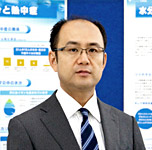
Increasing understanding using familiar topics and quantitative evidence
Sales Office Section 2,
Hiroshima Office Hiroshima Branch,
Nutraceuticals Division.
Takahiro Ono
In 2014, I conducted a Heat Disorder Prevention Seminar for 350 members of the Nippon Express Fukuyama Branch staff who do shipping work at a steelworks.
The Otsuka Pharmaceutical Hiroshima Branch office has been cooperating with this branch of Nippon Express for five years. The Fukuyama Branch not only provides its entire staff with training on heat disorder prevention, but also has in place an extremely detailed action plan for preventing heat disorders on the job. In addition, they recently started soliciting ideas from staff members on additional ways to prevent heat disorders, and they actively test out new ways of achieving this, such as preventative measures that employees can take on their own.
As for me, I attend both in-house study sessions and outside training sessions to learn the basics of giving seminar presentations. In my seminars, I add to these basics by incorporating temperature and humidity data for Hiroshima Prefecture, as well as information on trends that the attendees will be interested in. These materials are designed to convey just how big of a problem heat disorders is and how easily it can affect them. I also present evidence based on quantitative data that clearly explains heat from vaporization, the components of sweat and the ingredients of Pocari Sweat. My goal is to put this information together in a way that gives participants a concrete understanding of what causes heat disorders and how to prevent them.
Heat disorders in the family setting are just as serious as heat disorders among employees in the workplace. In addition to helping workers at the steelworks eliminate heat disorders on the job, I believe another important part of my work is to provide participants with information on preventing heat disorders among their family members, as well.
I will continue to fine-tune the content, structure and method of conveying information in my seminars so that everyone who participates can explain clearly to their loved ones what causes heat disorders, how to recognize the symptoms, and how to prevent and treat heat disorders.
Beyond all this, my ultimate goal through running these seminars is to build deeper, more trusting relationships.
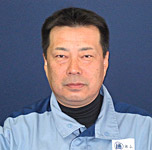
Eliminating heat disorders in the workplace
Manager, Occupational Safety Department,
Fukuyama Branch,
Nippon Express Co., Ltd.
Hiroshi Funamoto
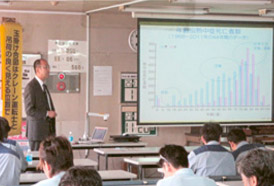
The Fukuyama Branch of Nippon Express is located on an industrial site and employs some 400 people; there are shifts around the clock. Every year, we implement various measures to prevent heat disorders, concentrating our efforts on the summer months. We believe that managers and supervisors must understand the dangers of heat disorders in order to prevent them, and that workers must understand that there is a real and personal risk to them.
Our efforts start in April, when incoming employees receive training on heat disorder prevention under the instruction of public health personnel, as part of their safety training. In the week following the national holidays in May, we have instructors from Otsuka Pharmaceutical conduct multiple seminars on heat disorder prevention for all employees, including managers and supervisors.
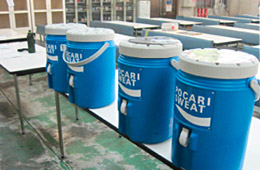
The next phase involves equipment and facility measures. Starting in June, we set up large coolers filled with Pocari Sweat in the break areas of each workplace. Workers are encouraged to drink one cup of Pocari Sweat before starting their work, and must carry a bottle with them for hydration. Additionally, workers carry a thermometer and hygrometer, and are instructed to check ambient temperatures and humidity three times a day, at 10:00 a.m., 1:00 p.m., and 4:00 p.m. respectively. The data is reported to managers and supervisors, who check the data against a posted chart showing the number of continuous hours worked. If necessary, work is suspended when the risk of heat disorders occurring is judged to be high.
Workplaces have an air-conditioned, enclosed space that is equipped with a refrigerator. These rest spaces are used by small groups to conduct their pre-work meetings. During the summer, workers also use the rest spaces for taking breaks and cooling off. They are stocked with salty candies for sodium replenishment, ice treats for cooling down, and OS-1 oral rehydration drinks in case workers feel ill. Workers also record hourly temperature and humidity readings and their break times on a white board.
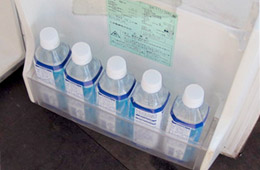
The top priority for managers and supervisors is getting a good idea of each worker's condition. Upon checking in at the company, workers record the numbers of hours they slept the night before and whether they had a meal before coming to work. The facial appearance of workers is checked for signs of good health and anyone who does not pass is removed from line work. Workers also record their fluid intake and the number of bathroom trips to help monitor their condition, and are reassigned to different work if they do not feel well.
From June through September, during the workplace general meeting that is held at the start of work each day, employees are reminded to keep hydrated, and the message of avoiding the risk of heat disorders is reinforced.





